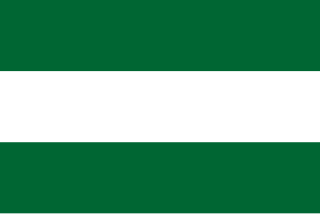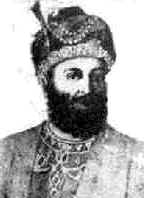
Ahmad Shāh Durrānī, also known as Ahmad Shah Abdālī, or Ahmad Khān Abdālī,, was the founder of the Durrani Empire and is regarded as the founder of the modern state of Afghanistan. In July 1747, Ahmad Shah was appointed as the King of Afghanistan by a loya jirga in Kandahar, where he set up his capital. Assisted by a council of nine advisers from various Afghan tribes, Ahmad Shah pushed east towards the Mughal and Maratha Empires of India, west towards the disintegrating Afsharid Empire of Iran, and north towards the Khanate of Bukhara of Turkestan. Within a few years, he extended his control from Khorasan in the west to Kashmir and North India in the east, and from the Amu Darya in the north to the Arabian Sea in the south.

The Durrani Empire or the Afghan Empire, also known as the Sadozai Kingdom, was an Afghan empire that was based in Central Asia and founded by Ahmad Shah Durrani in 1747. At its zenith, it ruled over the modern-day countries of Afghanistan and Pakistan, as well as parts of northeastern and southeastern Iran, eastern Turkmenistan, and northwestern India. Next to the Ottoman Empire, the Durrani Empire is considered to be the greatest Muslim empire of the latter half of the 18th century.

Herāt is an oasis city and the third-largest city of Afghanistan. In 2020, it had an estimated population of 574,276, and serves as the capital of Herat Province, situated south of the Paropamisus Mountains in the fertile valley of the Hari River in the western part of the country. An ancient civilization on the Silk Road between the Middle East, Central and South Asia, it serves as a regional hub in the country's west, and its historic Persian influences has given it the nickname as Afghanistan's Little Iran.

Kandahar is a city in Afghanistan, located in the south of the country on the Arghandab River, at an elevation of 1,010 m (3,310 ft). It is Afghanistan's second largest city after Kabul, with a population of about 614,118. It is the capital of Kandahar Province as well as the de facto capital of the Taliban, formally known as the Islamic Emirate of Afghanistan. It also happens to be the centre of the larger cultural region called Loy Kandahar. In 1709, Mirwais Hotak made the region an independent kingdom and turned Kandahar into the capital of the Hotak dynasty. In 1747, Ahmad Shah Durrani, founder of the Durrani dynasty, made Kandahar the capital of the Afghan Empire.

Herat is one of the thirty-four provinces of Afghanistan, located in the north-western part of the country. Together with Badghis, Farah, and Ghor provinces, it makes up the north-western region of Afghanistan. Its primary city and administrative capital is Herat City. The province of Herat is divided into about 17 districts and contains over 1,000 villages. It has a population of about 2,187,169, making it the second most populated province in Afghanistan behind Kabul Province. The population is multi-ethnic but largely Persian-speaking. Herat dates back to the Avestan times and was traditionally known for its wine. The city has a number of historic sites, including the Herat Citadel and the Musalla Complex. During the Middle Ages Herat became one of the important cities of Khorasan, as it was known as the Pearl of Khorasan.

Emir Dost Mohammad Khan Barakzai, nicknamed the Amir-i Kabir, was the founder of the Barakzai dynasty and one of the prominent rulers of Afghanistan during the First Anglo-Afghan War. With the decline of the Durrani dynasty, he became the Emir of Afghanistan in 1826. He was the 11th son of Payendah Khan, chief of the Barakzai Pashtuns, who was killed in 1799 by King Zaman Shah Durrani.

The Timurid Empire, self-designated as Gurkani, was a Persianate Turco-Mongol empire comprising modern-day Uzbekistan, Turkmenistan, Tajikistan, Kazakhstan, Iran, the southern region of the Caucasus, Iraq, Kuwait, Afghanistan, much of Central Asia, as well as parts of contemporary Russia, India, Pakistan, Syria and Turkey.

Mahmud Shah Durrani ; 1769 – April 18, 1829), also known as Shah Mahmud, or Mahmud Shah Abdali, was born a Prince and later became the ruler of Durrani Empire (Afghanistan) between 1801 and 1803, and again between 1809 and 1818. From 1818 to 1829, he was the ruler of Herat. An ethnic Sadduzai tribe section of the Popalzai sub clan of the Durrani Pashtuns, he was the son of Timur Shah Durrani and grandson of Ahmad Shah Durrani.

The Kart dynasty, also known as the Kartids, was a Sunni Muslim dynasty of Tajik origin closely related to the Ghurids, that ruled over a large part of Khorasan during the 13th and 14th centuries. Ruling from their capital at Herat and central Khorasan in the Bamyan, they were at first subordinates of Sultan Abul-Fateh Ghiyāṣ-ud-din Muhammad bin Sām, Sultan of the Ghurid Empire, of whom they were related, and then as vassal princes within the Mongol Empire. Upon the fragmentation of the Ilkhanate in 1335, Mu'izz-uddin Husayn ibn Ghiyath-uddin worked to expand his principality. The death of Husayn b. Ghiyath-uddin in 1370 and the invasion of Timur in 1381, ended the Kart dynasty's ambitions.

The Hotak dynasty was an Afghan monarchy founded by Ghilji Pashtuns that briefly ruled portions of Iran and Afghanistan during the 1720s. It was established in April 1709 by Mirwais Hotak, who led a successful revolution against the declining Persian Safavid empire in the region of Loy Kandahar("Greater Kandahar") in what is now southern Afghanistan.

The Arghun Dynasty was a dynasty of either Mongol, Turkic or Turco-Mongol ethnicity, who ruled over the area between Southern Afghanistan and Sindh from the late 15th century to the early 16th century. The Arghuns claimed their descent and name from Ilkhanid-Mongol Arghun Khan. Arghun rule can be divided into two branches: the Arghun branch of Dhu'l-Nun Beg Arghun that ruled until 1554, and the Tarkhan branch of Muhammad 'Isa Tarkhan that ruled until 1591.

Alakozai is the name of a Pashtun tribe in Afghanistan. Spelling variations include Alakozi, Alakoozi, Alekozai, Alekuzei, Alikozai, Alokozay, Alokozay, Alkozai, Alokzai, Hulakozai, Alecozay, Alikusi, and Alakuzei. They are one of the four tribes of the Zirak tribal confederacy of Durrani Pashtuns.
Abul-Qasim Babur Mirza, was a Timurid ruler in Khurasan (1449–1457). He was the son of Ghiyath-ud-din Baysunghur ibn Shah Rukh Mirza, and thus a great-grandson of Amir Timur.

Timur Shah Durrani, also known as Timur Shah Abdali, or Taimur Shah Abdali, was the second ruler of the Afghan Durrani Empire, from November 1772 until his death in 1793. An ethnic Pashtun, he was the second eldest son of Ahmad Shah Durrani. Timur Shah would prominently be the governor of many cities in Punjab for the Durrani Empire, however usually forced out after Sikh armies would defeat him in battle. Timur Shah's reign would began after the death of his father, Ahmad Shah Durrani. This event would place the Durrani Empire into disarray, as multiple combatants would begin fighting for power, Timur Shah led a successful campaign against a coalition his brother, Humayun Mirza had made, securing power for himself. His prominent reign would see the Durrani Empire being held through tough times, Timur Shah also notably changed the capital of the Durrani Empire from Kandahar to Kabul, which is what would affect the state of modern Afghanistan today, with Kabul as its Capital city. Timur Shah also used Peshawar as his winter capital.
The following is a timeline of the history of the city of Aleppo, Syria.
The following is a timeline of the history of the city of Samarkand, Uzbekistan.
The following is a timeline of the history of Kabul, Afghanistan.
The following is a timeline of the history of the city of Mashhad, Iran.

The Khanate of Nishapur, also known as the Qara Bayat Amirdom, was a semi-independent state ruled by the Bayat tribe that existed in Khorasan from 1747 to 1800, whose capital was in the city of Nishapur.

The Principality of Herat, the Emirate of Herat, the Herat Khanate or simply Herat was a state in Afghanistan from 1793 to 1863, and one of the 3 main khanates in 19th century Afghanistan.















